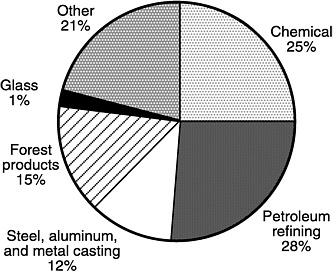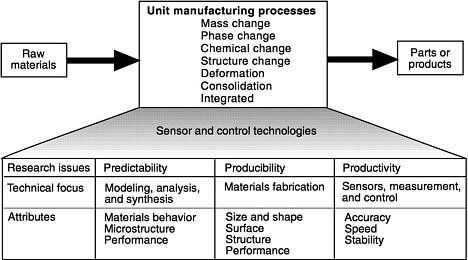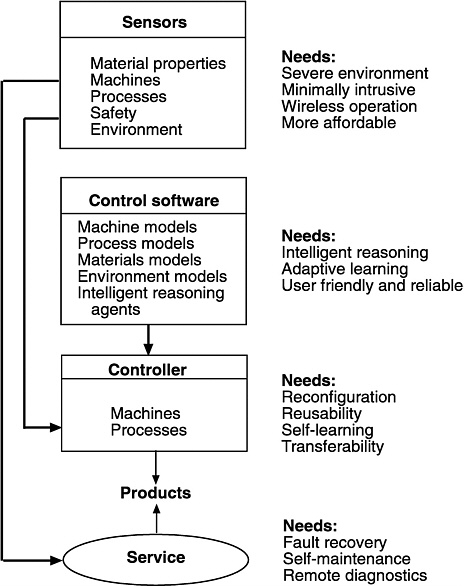1
Introduction
The U.S. Department of Energy (DOE) Office of Industrial Technology (OIT) sponsors research and development projects to improve energy efficiency and resource utilization in energy- and waste-intensive industries. The research and development projects focus on materials processing industries and are aimed at developing technologies that reduce the use of raw materials and energy, reduce the amount of waste generated, and increase industrial productivity and global competitiveness.
Since 1993, the OIT has been undergoing a transition from a “technology push” program strategy, in which research projects are selected and prioritized primarily for their potential to reduce energy consumption or waste generation, to a “market pull” strategy, in which identified industry needs and priorities are the primary criteria for selecting projects. To pursue the new strategy, the OIT focused on seven energy- and waste-intensive materials processing industries: aluminum, chemicals, forest products, glass, metal casting, steel, and petroleum refining. These industries, designated “Industries of the Future” (IOF), use about 80 percent of the energy (Figure 1-1) and produce more than 90 percent of the manufacturing waste in the entire U.S. industrial sector. The petroleum refining industry elected not to participate in the IOF program, and, in 1997, the agriculture industry, specifically renewable bioproducts, was added to the group.
Representatives of the selected industries, including industry organizations and trade associations, developed technology “visions” that identify their high-priority needs, including their strategic goals and research priorities. Table 1-1 shows the status of the vision documents for each industry. Based on these visions, the industry groups have developed technology “road maps” (research agendas), devised implementation strategies to meet their high-priority needs,

FIGURE 1-1 Manufacturing energy use (1994). Total energy use is 22.4 Quads (quadrillion BTUs). Source: Office of Industrial Technologies (DOE, 1997) (based on Energy Information Administration data).
and committed resources to conduct and manage the research projects. OIT facilitates the process by assisting and planning, by coordinating participants and catalyzing interactions, by providing access to the DOE-administered national laboratories, and by sharing the costs of selected projects.
COMMITTEE ON INDUSTRIAL TECHNOLOGY ASSESSMENTS
The OIT requested that the National Research Council (NRC), through the National Materials Advisory Board, conduct a study to (1) evaluate their program strategy, (2) provide guidance during the transition to the new “market pull” IOF strategy, and (3) assess the effects of the change on cross-cutting technology programs, that is, programs to develop technologies applicable to several industries. The Committee on Industrial Technology Assessments (CITA) was established to review and evaluate the program and plans of the overall OIT program, review the plans and progress of selected OIT-sponsored research programs, and conduct site visits and laboratory evaluations, when appropriate, to supplement program assessments. The committee will suggest improvements to the technical programs, methods of coordinating research with other agencies, and mechanisms for transferring technology to industry.
To help the committee review the overall OIT program, CITA establishes and oversees topical panels to review selected aspects of the program, conduct site visits if necessary, and bring in additional members with topical expertise.
TABLE 1-1 Status of IOF Vision Documents
|
Industry Sector |
Vision Document |
Date Released |
|
Forest Products |
Agenda 2020: A Technology Vision for America's Forest, Wood, and Paper Industry |
November 1994 |
|
Metal Casting |
Beyond 2000: A Vision for the American Metalcasting Industry |
September 1995 |
|
Steel |
Steel: A National Resource for the Future |
May 1995 |
|
Aluminium |
Partnerships for the Future |
March 1996 |
|
Glass |
Glass: A Clear Vision for a Bright Future |
January 1996 |
|
Chemicals |
Technology Vision 2020: The U.S. Chemical Industry |
December 1996 |
|
Agriculture |
Plant/Crop-Based Renewable Resources 2020 |
Draft |
The first panel evaluated the intermetallic alloy development program at the Oak Ridge National Laboratory (NRC, 1996a). This program was selected because it is mature and already focused on cross-cutting research and development. The emphasis of the report was on lessons that could be derived from the development of nickel aluminide alloys and processes, which have been the focus of the OIT intermetallics research program at Oak Ridge National Laboratory. The report included a review and assessment of the intermetallic alloy development program and recommendations for the future focus of the program, as well as an assessment of implications for the entire OIT program and the transition to the IOF strategy.
PANEL ON MANUFACTURING PROCESS CONTROLS
The second topical panel established under CITA was the Panel on Manufacturing Process Controls. The objective of this panel was to identify opportunities for technological development that could improve process controls in the materials processing industries of the IOF and to recommend areas of emphasis for a sensors and controls initiative. The study tasks included
-
the identification of key processes and needs for improved manufacturing control technologies, especially the needs common to several IOF industries
-
the identification of research opportunities to address these needs
-
suggested criteria for identifying and prioritizing research and development projects for improved manufacturing controls technology
-
the identification of mechanisms for transferring advances in control technologies to IOF industries

FIGURE 1-2 Research issues, technical focus, and attributes of process sensors and controls. Unit manufacturing process categories are taken from NRC (1995).
Much of the information used to develop the research recommendations was the result of two workshop sessions conducted by the panel. The first workshop included representatives of six of the IOF industry groups1 (aluminum, chemicals, forest products, glass, metal casting, and steel), who discussed their needs for process control and sensing technologies and identified the common needs of multiple industries. The second workshop included experts on advanced sensing and control technologies, who identified opportunities for developing technologies to meet the industry needs. Workshop agendas are included in Appendix A. This report is a summary of the panel's findings and contains recommendations for future research.
CHALLENGES
Sensor and control technologies are integral components of all modem processing industries. These technologies are essential to the evaluation and monitoring of the material properties, quality (of machines, processes, and products), process safety, and energy efficiency of industrial processes. In general, sensors and controls are used by process industries to address three operational issues—predictability, producibility, and productivity—in various manufacturing processes (Figure 1-2). Sensors supply the data that are used to monitor and control product and process variables. The process controller uses real-time control strategies and algorithms to relate sensory feedback to process decision making.
|
1 |
Two IOF groups did not participate in the workshop, the petroleum refining industry and the agriculture industry, which had not yet joined the IOF. |
With recent advances in computing, communications, advanced materials, and microelectronics, sensors and process controls can now be more effectively integrated with real-time control models on both the component and system levels. However, as discussed in Chapter 2, the operation of sensors and process control technologies is limited in harsh environments.2 At the same time, increasing environmental constraints and regulations have made it imperative that industries be able to use state-of-the-art sensors and process controls. In addition, industries require manufacturing processes that can be quickly, easily, and affordably adapted to meet current and future production needs.
Technical Challenges
The factors driving the development of sensors and manufacturing process control technologies are (1) the need to reduce variability and improve quality, (2) environmental constraints, and (3) the need for easier servicing and maintenance. Figure 1-3 shows how these factors have created a general need for the development of intelligent sensors and control systems (NSF, 1997) to improve energy efficiency and resource utilization in energy-intensive and waste-intensive materials processing industries.
Reducing Variability and Improving Quality
Advanced sensors and process control systems that could monitor process variations would make high-quality operations feasible at lower costs. These will require the development of software engineering tools for the design and development of intelligent process control software that is both adaptable and reliable. Process control software includes real-time, embedded software that can compensate for the variability in machine performance, processing conditions, and materials properties. Advanced controllers for the process industries must offer features such as reconfigurability, reusability, self-learning, and knowledge transferability to minimize process variations.
Environmental Constraints
Innovative, robust sensory devices could improve energy efficiency and reduce waste while bringing down the costs of development and installation. Advanced sensors would be able to monitor process parameters and acquire process information directly, accurately, and quickly. In addition, innovative sensor materials and coating technologies could make the use of sensory devices in extreme high temperature and chemically corrosive environments feasible (NRC, 1996b).
|
2 |
A harsh operating environment has one or more of the following characteristics: high processing temperature (with respect to sensor and control capabilities), steep thermal gradients, corrosivity, erosivity, high particle content, combustion, or high processing speeds. |
Emerging technologies, such as microelectromechanical systems (MEMS)-based sensors (NRC, 1997; OTA, 1991) and wireless communications (Zoltowski, 1995), could be developed and optimized to meet industrial needs for sensors.
Servicing and Maintenance
Servicing and maintenance are important factors in the productivity of process industries. The recent rush to embrace computer-integrated manufacturing technologies in the process industries has increased the use of relatively unknown and untested technologies, making it difficult to identify the causes of system failures. The difficulty has been attributed to several factors, including system complexity, uncertainties, and the lack of adequate troubleshooting tools. Currently, many servicing and maintenance activities in process industries are still reactive.
Manufacturers need to emphasize manufacturing processes, equipment, and products that improve cycle time, reduce defects, and add value while accounting for process variation. Thus, process controllers will have to provide proactive maintenance capabilities, such as measurements of performance degradation, fault recovery, self-maintenance, and remote diagnostics (Lee, 1995, 1996). These features would allow process industries to develop proactive maintenance strategies that would guarantee process performance and would eliminate many system breakdowns. An example of a proactive maintenance strategy is condition-based maintenance that considers the actual condition of the equipment, rather than the more conventional strategies that consider time-based or usage-based maintenance strategies or that simply respond to equipment failures. Condition-based maintenance will require the development of sensors and diagnostic techniques to monitor critical operating conditions, such as temperature, vibration, and power consumption. The U.S. Department of Defense, especially the Army, the Navy, and the Defense Advanced Research Projects Agency (DARPA), has been sponsoring significant research and development on condition-based maintenance.
Intellectual and Infrastructural Challenges
Research resources can be used most effectively if they are focused on key intellectual and infrastructural challenges and combine analytical, computational, and experimental approaches. One goal should be to develop innovative manufacturing processes and methodologies for making useful products from both new and recycled materials. A better understanding of the behavior of materials during processing would facilitate the development of innovative technologies for analytical models and physical prototypes of next-generation machines and manufacturing equipment. Innovations could include new designs for machine components, more reliable sensing techniques, enhanced metrology, and more robust control technologies.
The major intellectual challenge will be to increase scientific knowledge that could lead to innovations in a broad spectrum of manufacturing processes and equipment. Manufacturing engineers must keep the issues involving the complete design/production environment in mind during the development of manufacturing processes and equipment. Improved process sensing and control technology will require new scientific knowledge—from material behavior to product formation for current and future manufacturing processes—and the integration of manufacturing processes with design engineering and production systems. Because the overall manufacturing structures are similar for most industries, the information could be applied to many manufacturing technologies.
The infrastructural challenge is to integrate research facilities and education curricula across institutional boundaries, to harness diverse physical resources, and to encourage collaborative innovation. One of the biggest challenges in manufacturing research has always been applying ideas developed in basic research programs to operational manufacturing industries. The true value of an innovative idea can only be determined after production attributes (cost, quality, responsiveness, and optimization) have been validated in real production through an integration process involving materials, machines, methods, maintenance, money, and personnel. In an ideal situation, researchers could leverage resources available from various institutions (even across international boundaries).
REFERENCES
DOE (Department of Energy). 1997. OIT Technology Partnerships. DOE/GO-10097-334. Boulder, Colo.: National Renewable Energy Laboratory.
Lee, J. 1996. Measuring the machine performance degradation using a neural networks model. International Journal of Computers in Industry 30(3):193–209.
Lee, J. 1995. Modern computer-aided maintenance of manufacturing equipment and systems: review and perspective. Journal of Computers and Industrial Engineering 28(4): 793–811.
NRC (National Research Council). 1997. Microelectromechanical Systems: Advanced Materials and Fabrication Methods. NMAB-483. National Materials Advisory Board. Washington, D.C.: National Academy Press.
NRC. 1996a. Intermetallic Alloy Development: A Program Evaluation. NMAB 487-1. National Materials Advisory Board. Washington, D.C.: National Academy Press.
NRC. 1996b. Expanding the Vision of Sensor Materials. National Materials Advisory Board. Washington, D.C.: National Academy Press.
NRC. 1995. Unit Manufacturing Processes. Manufacturing Studies Board. Washington, D.C.: National Academy Press.
NSF (National Science Foundation). 1997. Annual Report of the Manufacturing Processes and Equipment Program, Division of Design, Manufacture, and Industrial Innovation. Washington, D.C.: National Science Foundation.
OTA (Office of Technology Assessment). 1991. Miniaturization Technologies. Office of Technology Assessment, U.S. Congress. Washington, D.C.: Government Printing Office.
Zoltowski, M. 1995. Proceeding on Signal Processing for Smart Sensor Arrays: From Research to Application-Rich Technology Insertion. National Science Foundation Workshop, Washington, D.C., April 27–28, 1995.









